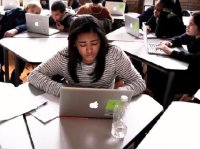Start a Reading Revolution: Flip Your Class With Blogs
By adding blogs to a flipped ELA class, teachers present literacy as a design challenge where words, images, and format serve to express students’ ideas.
Are kids actually reading? It's a worthwhile question. In an age when distractions seem to make readers more reluctant, one must wonder how many students actually do it.
There's evidence to support this fear. Grant Wiggins recently published a survey of a typical American high school. It found that English is students' least favorite subject, and worse, they despise reading. Here's some student feedback:
It doesn’t have to be this way. A reading transformation can occur in your school much like it has in my classroom, replacing fear and dread with excitement and self-expression. Students will read if they choose the books. They will write with voice and clarity if they have the ability to express their thoughts. They can change from reluctant to inspired readers if it happens on their own terms. All you have to do is flip the experience, turning the practice of reading on its head by making them the creators of their own learning.
The Flip
In flipped classrooms, students watch online lectures at home so that they can engage in project-based learning during the school day. Frequently used in math and science classes, the flip has upended traditional learning as teachers spend less time lecturing and more time coaching. Students can access the teacher's help more frequently, increasing the likelihood of improvement and understanding.
But what does flipping look like in an English or reading classroom? This question troubled me because so much had been written about its use in math and science but so little attention was paid to the language arts. In many English and reading classes, students focus on one common text (like a novel) and take notes, complete worksheets, or do group work. The reading occurs at home, far away from the assistance of a teacher. The trouble is, there is no way to know for sure whether students are actually reading, let alone enjoying the experience, nor any chance to help them when they struggle.
The Solution
I realized that the traditional English experience needed to be turned upside down. Students should have an opportunity to read in class and a choice in what they read. Rather than answer teacher-generated questions on a study guide, students should be empowered to write what they want in the format they deem fit.
My flip, which I first explored two years ago, did all of these things, and created a contagious atmosphere of passionate readers. Its two cornerstones are choice and blogs. This approach has completely changed the way I teach reading, with my students repeatedly saying that it was the best and most important unit of the year.
Overview
- Students choose any work of fiction appropriate for their reading level (in my AP Literature class, students read AP-worthy books).
- Students read in class 3-4 times a week for 2.5 weeks. They must read actively, but get to choose their method: index cards, post-it flags, bullet points in their notebooks, etc.
- At home, students write on their blog using the Writing to Learn method. They have the freedom to craft posts on topics of their own choosing.
- Every day that they read in class, students blog about the experience at home.
Fear
I know what you're thinking right now. How is it revolutionary if the students are reading all period? What instruction is actually going on? This was a significant concern of mine as well. Yet while they read, I coach. I'm either commenting on their blogs or moving from desk to desk providing strategies and assistance. More meaningful than that, what's really happening is a movement toward mastery as defined by the Common Core State Standards. It seeks students that:
If you look at my students' blogs, they are doing all of these things. They are independent readers and writers existing as autonomous learners. They are evaluating complex texts and conveying intricate, multi-faceted information. They are reading and writing for clarification and asking insightful questions of the text.
Why Blogs?
This unit is all about empowering students by providing freedom. The blogs add a maker mentality, stirring the imagination to create, design, and tinker. They choose their theme, incorporate images and gifs, and decide if they want to promote their work via social media platforms. No longer must they be told what to write and how, submitting to another's power and authority. Blogs provide choice and independence, allowing them to own the learning experience.
They also add a dimension that essay writing or journaling can never match: expansion. Once students publish a post, their writing passes the four walls of the classroom and exists to the world. This puts their work "out there," and that changes how they approach their writing. No longer just about impressing the teacher, their writing exists unto a larger audience -- classmates, friends, and the blogosphere -- whom they seek to wow.
Authentic Learning
Socrates once said, "I cannot teach anybody anything, I can only make them think." Flipped reading with blogs is a dynamic way for students to control their learning. It revolutionizes the way they view reading and writing, presenting it as a design challenge in which words, images, and format serve to express their ideas.
